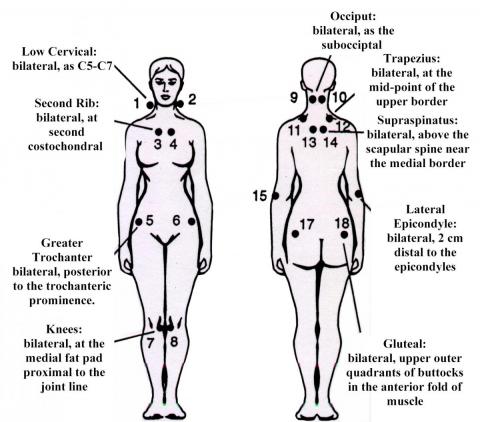|
Synchronizers are reflex points from a system of wellness developed by Sharon W. Giammatteo (Integrative Manual Therapy). There are several synchronizers associated with the thalamus (sensory and pain center for the body). One way to use synchronizers is to put one hand on the painful area and the other hand on the synchronizers. The hands can be your hands or another person's hands connecting the two places. Another way to use synchronizers is to put one hand on the synchronizers and the other hand on the area of the brain or body that is associated with that synchronizer. An access point for the thalamus is at the right and left temple area of the head. These synchronizers may also be connected to the Fibromyalgia points (ie) one hand on the synchronizer and the other hand over one of the fibromyalgia pain points (shown below). All of these point are beneficial for someone with fibromyalgia, chronic pain, reflex sympathetic dystrophy or an acute injury. Integrative Manual Therapy Synchronizer points for the Thalamus and Eliminating Pain 1. Heart, all aspects 2. Superior surface of the talus bone at the ankle. 3. Right side of the head where the face meets the upper part of the head (cranial vault). As you rest for 5-30 minutes making these connections you can also do visualizations or motor imagery. Motor imagery or guided imagery would be imagining the area of the body where you have pain receiving an increase in blood flow, nutrients and warmth. You can also imagine moving your body in a pain-free way or visualize someone else doing the movements you want to be able to do pain - free. Fibromyalgia Pain Points
0 Comments
Exercise Tip: Go outside in the morning light and look around at things that are moving in time: swaying trees, cars, people, flying birds, waving flags. Feel for the beating of your heart or the rhythm of your breathing. Do you feel yourself in sync with the universe?
People complain about being slaves to time—being on time. There is a clock inside each of us—our brains, our bodies, right down to our cells—that is syncing up every moment to the world around us. Our cells and brain notices the words we use and the way the light changes as the sun circles the sky. "If we’re having lunch, you and I will unconsciously pick up our forks more or less at the same time. There’s a great study about two people playing the game WhackAMole. Even though they were competing against each other, their movements fell into synch, even at the expense of losing points. They would unconsciously work toward this synchrony. If I watch a video of two people talking, I will be able to tell, unconsciously, how friendly they are, based on the extent to which their movements fall into synch with each other," said Alan Burdick, speaking about his book, Why Time Flies: A Mostly Scientific Investigation. In movies where it seems that a child is mimicking the actions of an adult the actors are actually doing the opposite because it is easier for the adult to mimic what the child is doing than to ask a five year old to adjust the flow and rhythm of how they move, even if the scene is portrayed that way. Try this: pair up with someone, stand facing each other, and take turns following the other person's hand movements. How hard is it? Do you get better over time? Many rhythms in the body, known as circadian rhythms or circa (about) dian (a day) regulate our physiology on a 24 hours cycle. The most prominent cycle is the sleep-wake cycle. When these rhythms are disrupted the ability to sleeping deeply and waking up rest and ready to go, suffers. In a 2016 article researchers noted, "Circadian rhythms modulate many physiologic processes and behaviors. Circadian disruption [in rats] induced by constant light exposure has been discovered to produce pathophysiologic [disease] consequences after brain injury. Our results showed that 14 days of constant light exposure after TBI significantly worsened the sensorimotor [sensation and muscle movement] and cognitive deficits, which were associated with decreased body weight, impaired water and food intake, increased cortical lesion volume, and decreased neuronal survival [further brain damage]. Our novel findings suggest that light exposure should be decreased and circadian rhythm reestablished in hospitalized TBI patients." (Li, D., S. Ma, et al. (2016). "Environmental Circadian Disruption Worsens Neurologic Impairment and Inhibits Hippocampal Neurogenesis in Adult Rats After Traumatic Brain Injury." Cell Mol Neurobiol 36(7): 1045-1055. Our relationship to time can be balanced by paying attention to the kind and amount of light we are exposed to. Sunlight in the morning and no screens for at least the 30-60 minutes before we plan to go to sleep are a key to sleeping better. Request a Free PDF copy of the full article via email Burnham, Kimberly (2017 03 01). "Balancing the Brain and Being On Time." ABI Magazine, Acquired Brain Injury https://abimagazine.wordpress.com/. Email Kimberly Burnham at NerveWhisperer@gmail.com Mention your top 8 health goals for 2018 for a free report on how you can feel better with easy self-care exercises. [Full Article] https://issuu.com/debbiest.jean/docs/arm_spring_issue_volume1-issue2 Connect with Kimberly Burnham on Social Media or Email for a Free Report on Brain Health Exercises, Mention your top 8 Health Goals for 2018. |
Kimberly Burnham, PhD (Integrative Medicine)
860-221-8510 phone and what's app. Skype: Kimberly Burnham (Spokane, Washington) NerveWhisperer@gmail.com 4 Month Brain Health Coaching Package $600 includes: 8 one hour session (twice a month) plus ... Details Here
Regular Rate $120 per hour
Free 20-30 minute consultations available.. Call 860-221-8510 PST or email NerveWhisperer@gmail.com for an appointment this week.
Archives
January 2018
Categories
All
|



